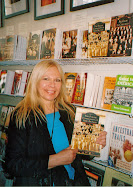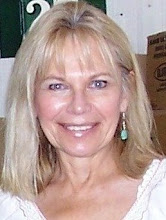It's easy to take Listservs for granted in genealogy. There are countless numbers of them online, devoted to every conceivable aspect of family history research. They are free (and conventional wisdom says people value services more when they have to pay for them). They are effortless, for members content to do no more than open e-mail, read, and lurk. (In contrast, they can be very labor-intensive for the dedicated souls, unsung heroes one and all, who organize and moderate them.)
I don't take lists for granted. When I reflect on some of the major successes I've enjoyed in genealogy over the past 15 years, it is clear that they have been due largely to the invaluable help I received from the early genealogy forums and user groups (once sponsored by AOL, CompuServe, Prodigy, etc.) and from Listservs.
Very best example: My father's family lost contact with some cousins in Belarus after my paternal grandmother, Anna, died in 1976. In 1998, a young woman named Ilona (either from the Belarus Discussion list connected to
A Belarus Miscellany online, or from the
soc.culture.belarus group, I can't recall; all our correspondence was via AOL) found those cousins for me within five months. I e-mailed her JPGs of some photos dating back to the 1950s-60s. She e-mailed them to her father, who was a physician in Radun, Belarus. He showed them to everyone he came in contact with. Within a couple weeks, someone recognized my cousin Maria from a 1965 photo. Ilona's father drove to Maria's village to meet her and relate this story. He e-mailed Ilona Maria's address; Ilona e-mailed it to me. When I traveled to Belarus in 2001, I finally met Maria and her family. Extraordinary! Could I have done this on my own? Maybe ... but it seems unlikely.
Just recently, a member of one of my favorite lists e-mailed me some JPGs of church records that had caught his eye while he was doing his own family research. He thought they might interest me, since they involved two Prokopowicz families from our mutual ancestral area. Among them was the 1845 baptismal record of my maternal great-grandfather, Kazimierz Prokopowicz! How many years had I been looking for that? Oh, only about 15. I simply hadn't hit on the correct year in my search. Kazimierz had been my missing link. Seeing his father's name on the baptismal record allowed me to take that family line back three more generations.
The incredible good karma of Listservs
In between Ilona in 1998 and Marek in 2010, dozens of fellow list members have helped me in more ways than I can detail here. They have been from all over North America, Europe, and Australia. We have communicated in English, Polish, and Russian (just a few feeble attempts on my part). They have explained and translated arcane 18th-19th-century Polish and Russian terminology, offered insight into history and culture, and shared PDFs of documents and URLs of Web sites. Always generously, always graciously. Honestly, I have always tried to be equally helpful on my lists, whenever I've felt I had something worthwhile to offer. Good karma is a two-way street.
Since 1996, I've subscribed to many genealogical Listservs—some Polish (my ethnic heritage), some Belarusian (my ancestral region has been within the boundaries of western Belarus since 1945), some Lithuanian (my paternal family villages and parishes straddle today's border of Belarus and Lithuania), some Russian (my ancestral region was within the boundaries of the Russian Empire for 125 years). Because my immigrant grandparents settled in Massachusetts, I've joined lists focused on that U.S. state and the New England region. About three years ago, I started a Yahoo! group called
PolishMass, specifically focused on Polish Roman Catholic immigration to Massachusetts. I've also joined lists sponsored by various genealogical societies and organizations and lists dedicated to specific topics, like Russian military history. (Seriously. It took me many years to get a satisfying explanation of the military status indicated by
zabiletny soldat.)
Every one of those Listservs has been worthwhile. I subscribe to them in digest form. This means that for each Listserv, I receive only one e-mail a day, and it contains all the messages posted in the past 24 hours or so. Each day, a dozen or so lists appear in my inbox, and I read them with my morning coffee. Some I skim and delete quickly, some I spend considerable time with, depending on the topics.
Below are my four favorite Listservs. I have not identified any members by name, simply in respect for their privacy, as much as I'd like to give shout-outs to some of the most knowledgeable and helpful. The founders and moderators, whether named here or not, are all my heroes for providing such wonderful forums for thousands of family researchers. And among the thousands of list members, I'm happy to have made some genuinely great friends.
LidaRoots
http://groups.yahoo.com/group/LidaRoots/
If I could give a giant gold star, or some impressive trophy, or better yet, a great big hug, to my all-time favorite Listserv, it would be to
LidaRoots. The icons and flags on the home page for this Yahoo! group represent the ethnic and religious diversity that make this area of western Belarus so culturally rich. Unlike lists geared to specific narrow groups (my own
PolishMass among them),
LidaRoots opens its heart and mind to everyone with ancestry in this area or an interest in its history.
Founded by Tony Gabis in May 2002, this list currently has 223 members. At least a dozen of the more active participants are top-notch researchers, and the quality of discussion is the deepest, most substantial I've ever experienced on a list. Listservs don't get any better than this. And newbies are always welcome :)
Kresy-Siberia
http://groups.yahoo.com/group/Kresy-Siberia/
This list has garnered more than a thousand members since it was founded by Stefan Wisniowski in 2001. I can't improve upon the compelling description on its home page: "The 'Kresy-Siberia Group' brings into contact people from countries around the world with a special interest in the fate of over one million Polish citizens of various faiths and ethnicities (Polish, Ukrainian, Belorussian, Catholic, Orthodox, Jewish, etc.) arrested or deported from eastern Poland (Kresy) to special labour camps in Siberia, Kazakhstan and Soviet Asia. The circumstances of their odyssey and the tragic history of the Polish citizens under Soviet occupation during WW2 was hushed up by the Allies during the war to protect the reputation of the Soviet Union, an important ally fighting the Nazis.
"Sixty years later the survivors have aged and many have died. With this list we hope to bring together surviving deportees and their descendants to remember, learn, discover and spread the word of their ordeal to the world and to future generations."
What is truly outstanding about this list is that it has taken its energy and resources a step further to become an increasingly significant cultural force by means of the
Kresy Siberia Virtual Museum:
http://www.kresy-siberia.org/
This list has helped me to understand the experiences of my family in Poland's eastern borderlands, the
kresy, during and after World War II. And it has helped me to find detailed information about some of them and their own odysseys. I receive much more than I can possibly give here, and I am grateful beyond measure.
Lithuanian Genealogy
http://groups.yahoo.com/group/LithuanianGenealogy/
Founded in 1999 and sponsored by the Lithuanian Global Genealogical Society, this list has 2,277 members. Like
LidaRoots and
Kresy-Siberia, this is a dynamic, helpful group of people with some highly skilled members here and abroad. It has taught me much about the Lithuanian aspect of the Polish-Lithuanian Commonwealth and all its geographic and political morphing over the centuries. As I trace my paternal roots increasingly northward from Belarus into Lithuania, I expect my interest here to grow even stronger.
DNA-Newbie
http://groups.yahoo.com/group/DNA-NEWBIE/
More than 2,200 members have joined this group since it was created in 2005. I think that speaks to the ever-increasing interest in DNA research for genealogy. The list is sponsored by the International Society of Genetic Genealogy (ISOGG). The moderators are extremely knowledgeable and unceasingly helpful to people like me, who are, frankly, just trying to understand the results of the DNA tests we order to complement our paper-trail genealogical research.
I am not a sciencey person. My high school Algebra II teacher, Sister Mary Celine, made me promise not to major in math in college. No matter how many books I read or workshops I attend, very, very little of all those strings of numbers and ACGT letters on the test results mean anything to me. I am a DNA newbie. I am lucky someone started this list.
 The Seven Daughters of Eve focuses on mitochondrial DNA, or mtDNA, which is passed down matrilineally—from a woman to her daughter, to her daughter, to her daughter, generation after generation. Journey of Man traces Y-DNA, which is similarly passed down, patrilineally, from a man to his son, to his son, to his son, and so on. Both of these ground-breaking works look at the big picture: the evolution of the human species over thousands of years, through migration out of Africa and across the planet. Genealogy writ large.
The Seven Daughters of Eve focuses on mitochondrial DNA, or mtDNA, which is passed down matrilineally—from a woman to her daughter, to her daughter, to her daughter, generation after generation. Journey of Man traces Y-DNA, which is similarly passed down, patrilineally, from a man to his son, to his son, to his son, and so on. Both of these ground-breaking works look at the big picture: the evolution of the human species over thousands of years, through migration out of Africa and across the planet. Genealogy writ large.







